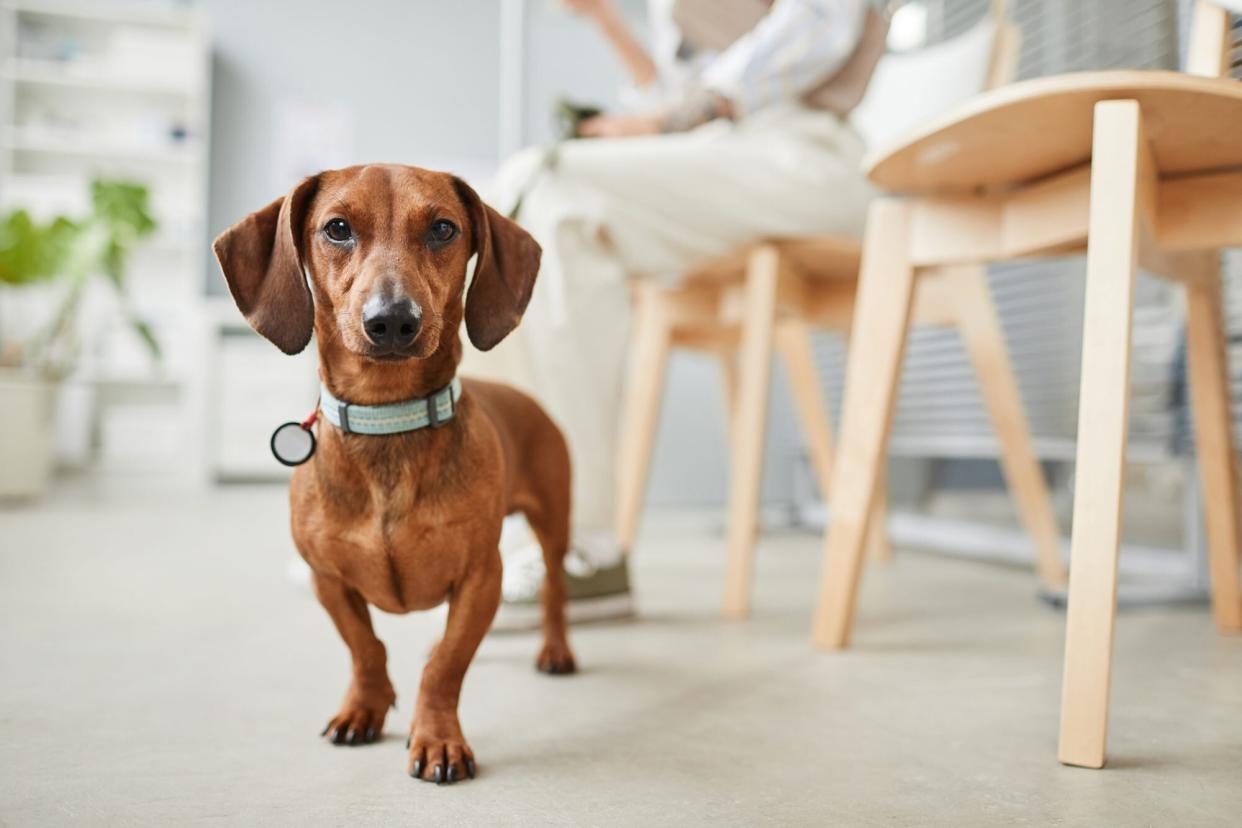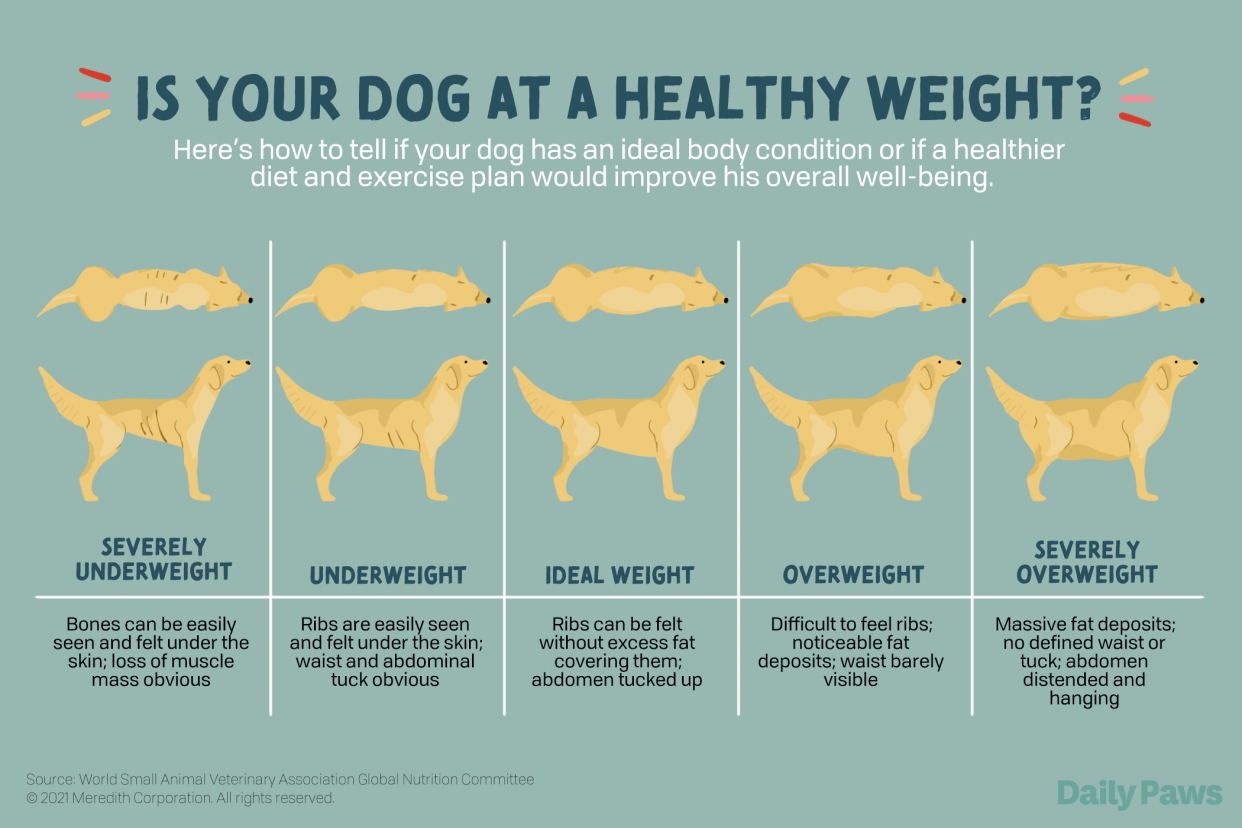This Dog Weight Chart Can Help Determine Your Dog's Healthy Weight and Body Condition

SeventyFour / Getty
Wouldn't it be easy if you could just weigh your dog and know instantly that she was just the right weight, just the right size, and perfectly healthy? Unfortunately, it doesn't work that way.
If you own a purebred dog, the American Kennel Club does offer an extensive weight chart for male and female adult dogs by breed. You can use general numbers to estimate how big a new purebred puppy might get. Bear in mind that even a pound or two in certain pure breeds can look different and significantly impact health even when in the 'appropriate range.' And if you've got one of the country's millions of mixed-breed dogs, dog weight calculators and charts are only so helpful.
"It's really difficult to know a healthy weight for a dog with just the scale," says Lori Prantil, MPS, DVM, who counsels pet owners on nutrition at VCA South Shore Weymouth. "There are so many different breeds, and so many mixed breeds."
Veterinarians don't judge a dog's healthy weight with one number. They also use body condition scoring and muscle condition scoring to figure out whether your beloved pooch is carrying too little or too much fat on her body or whether her muscles are starting to lose mass and definition.
Assessing your dog's healthy weight starts with regular visits to the vet (Prantil recommends twice a year). Your careful attention over time to how your dog's weight or body condition changes is also crucial.
RELATED: How Much Food Does Your Dog Really Need?
Dog Weight Chart: Where Is Your Pup on the Scale?
Your dog's weight and body shape can have a big impact on their overall health. Use this dog weight chart to see what your dog's body should look like at an ideal body condition and size.

Daily Paws / Caitlin-Marie Miner Ong
Severely Underweight
Your dog looks bony from a distance
Ribs, lumbar vertebrae (lower back bones) and pelvic (hip) bones can be seen under the skin
Body fat isn't discernible under the skin
Loss of muscle mass is obvious
Underweight
Your dog's ribs are easily felt and may be visible under the skin
Body fat may not be felt under the skin
Some other bony spots may be seen under the skin
From above, the waist (behind the ribs) is obvious
From the side, the abdomen is significantly tucked up (rather than running straight back to the legs)
Ideal Weight
Your dog's ribs are easily felt without excess fat covering them (may or may not be visible)
From above, the waist can be seen behind the ribs
From the side, the abdomen is tucked up and does not run straight back to the legs
Overweight
Your dog's ribs can be felt with difficulty with fat covering them
Noticeable fat deposits over the base of the tail and lumbar area (between pelvic bone and ribs on back)
Your dog's waist is absent or barely visible
Abdominal tuck may be present
Severely Overweight
Your dog has massive fat deposits over the thorax (from the neck to the abdomen), the spine, and the base of the tail
Waist and abdominal tuck are absent
Fat deposits are visible or can be felt under the skin on your dog's neck and legs
Your dog's abdomen is obviously distended and hanging
What Should You Do If Your Dog Isn't Their Ideal Weight?
If you've assessed your dog's body condition and weight and suspect she may be either overweight or underweight, there are steps you can take to get her on the right path to improved health. To start, it's always good to talk with your veterinarian. They will provide guidelines on how many calories to feed your dog by calculating caloric needs based on weight or by following the recommended daily calorie intake based on weight categories. Many hospitals have specific programs or staff to help your pets safely gain/lose weight over the course of weeks to months. As always, consulting with your vet on the best course of action for your individual dog is ideal.
For Underweight Dogs
For an underweight dog, explore common reasons why your pup may be underweight and follow your vet's tips to increase calorie intake, which might include increasing portion sizes, adjusting meal frequency, and/or trying a higher-calorie food.
For Overweight Dogs
For an overweight dog, in addition to slowly increasing exercise and play in her daily routine, reel in the treats and snacks (and definitely human food), then learn how to estimate how many calories you need to restrict in her diet while following tips to help her lose weight in a healthy way.
Whether your dog is under or overweight, by adjusting calories, adopting vet-approved healthy ways to increase or decrease their weight—and a little patience—you should see your pup's well-being improve with time.
